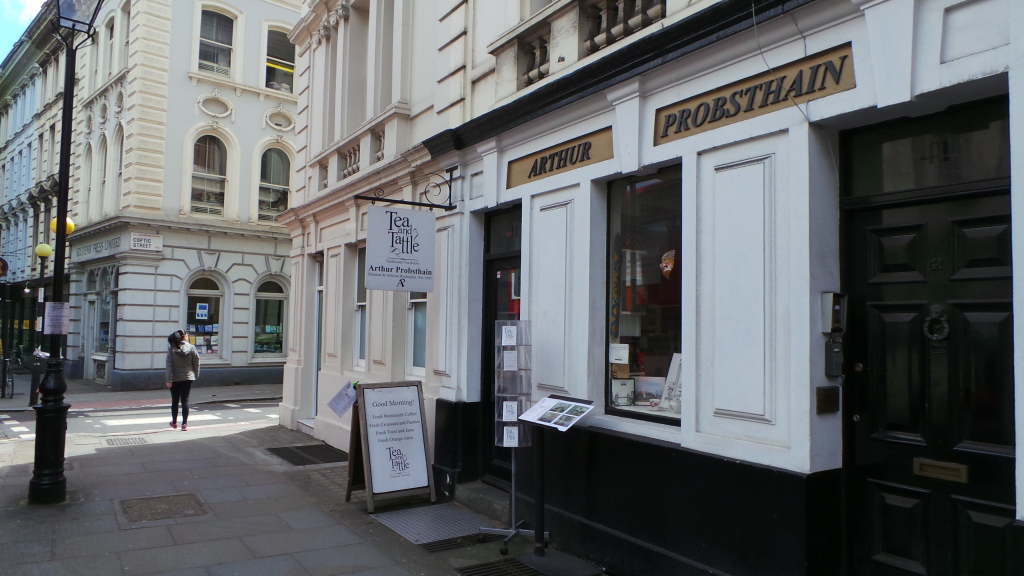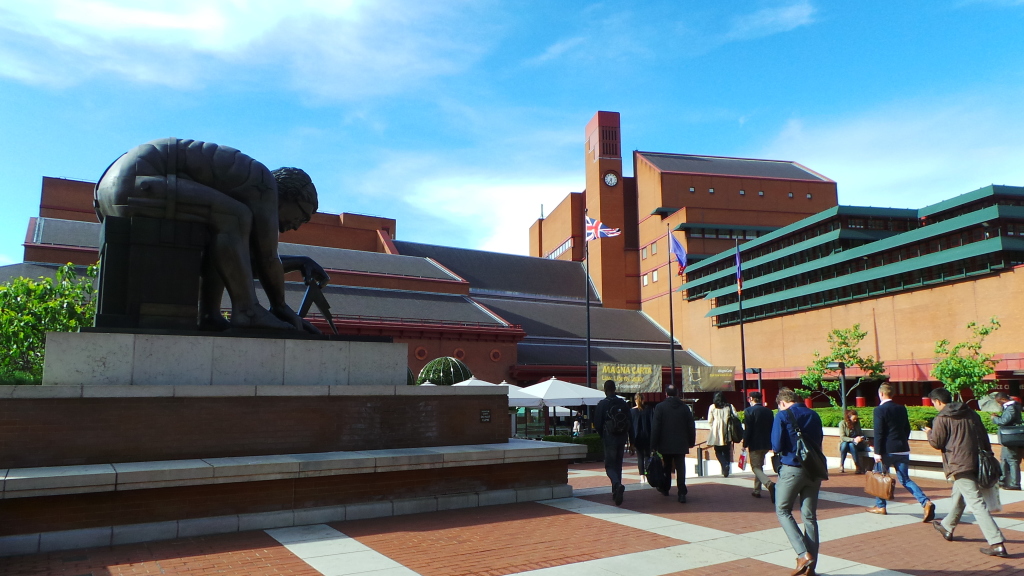
The Arthur Probsthain bookshop near the British Museum in the Bloomsbury district of London. Copyright 2015, anothercappuccino.com.
During my most recent trip to London I spent a day wandering around Bloomsbury, a leafy district known for its eminent publishing houses, museums and colleges, to visit three bookshops in the area, as well as the venerable British Museum. My first stop was Arthur Probsthain, an independent family-run bookshop that has been trading since 1903. The shop specializes in books on African and “oriental” topics, including those related to the Middle East and Asia. This bookshop is small; it has an atmosphere of tradition and exclusiveness, although I found the shop assistants to be knowledgeable and welcoming. Rather uniquely, there is a narrow winding staircase to the right of the entrance, which leads down to a tea room/café called The Tea and Tattle. The grand edifice of the British Museum is just across the road, and so the bookshop is perfectly situated for book browsing and a light snack either before or after a visit to the museum. I treated myself to a pot of Earl Grey in the tea room before heading to the museum to view the ancient Assyrian reliefs and Parthenon sculptures. This wonderful bookshop is located at 41 Great Russell St.
After spending about three hours at the British Museum, during which I saw the “Elgin Marbles” for the first time, I headed to the Waterstones bookshop at 82 Gower Street, located next to the University of London. From the museum, I walked along Montague Street to Russell Square, past the Brunei Gallery and the School of Oriental and African Studies (SOAS). The gallery has its own excellent little bookshop but I decided to pass it by on this occasion. I then swanned through the university campus to Woburn Square until I reached Byng Place, where I turned left and continued to Torrington Place; the Waterstones bookshop was then just a few steps further along the road. To be honest, if I had checked my map more carefully, I would have realized that a more direct route from the British Museum would have been for me to just walk along Gower Street, but my chosen route provided for a very pleasant walk nonetheless!

The Edwardian Gothic Waterstones bookshop on Torrington Place, London. Copyright 2015, anothercappuccino.com.
The bookshop has entrances on both Torrington Place and Gower Street. According to the Waterstones website, this is the largest academic-oriented bookshop in Europe. The building was built in the early 1900s in “flamboyant, Franco-Flemish Gothic style,” which is topped by a series of spires. It looks quite magical. The shop includes five floors of books, including a basement, and a Costa Coffee café with free Wi-Fi. The shop accommodates the pockets of students from the nearby colleges by offering previously owned as well as new books. Waterstones is probably the largest chain of bookstores across the U.K., but each store aims to meet the specific needs of the community in which it is located. The Waterstones at 82 Gower Street is a good example of this adaptability, since it offers a huge range of academic books to meet local needs. I must have spent at least a couple of hours browsing this bookstore and I was able to find several books on my book club reading list. I concluded my visit with a flat white at the Costa café. Phrases like “book Mecca” and “cathedral of books” are often overused, but in this case they seemed appropriate descriptions of this store.

The British Library building on Euston Road, located between the Charing Cross and St. Pancras train stations, London. Copyright 2015, anothercappuccino.com.
After leaving Waterstones, I made for the final port of call on my bookstore tour. This was the bookshop at the British Library, located nearby at 96 Euston Road. From Waterstones, I retraced my steps along Torrington Place and turned left on Gordon Square, which I then followed to Euston Road, almost opposite the train station. I turned right and walked along Euston Road, past St. Pancras Church, built in new-Greek style in 1819-22, which is famous for its caryatid porch inspired by the female figures supporting the porch of the Erechtheion on the Acropolis at Athens. After walking for about another 10 minutes I found myself opposite the British Library building, which was the largest public building built in Britain in the 20th century and opened in 1997. Its collection includes the Magna Carta and the original manuscripts of books written by such authors as Jane Austen and James Joyce among many others. It was my first visit to the British Library since I was a student in the 1980s, when I made several visits to the British Library Reading Room at the original British Museum site. The library hosts both permanent and temporary exhibits. 2015 is the 800-year anniversary of the signing of the Magna Carta and the library had an exhibit all about the historic document.
The bookshop is located on the left just inside the library’s main entrance. It sells an eclectic collection of fiction and classics, reflecting the library’s mission to promote high quality writing and ideas from around the world. I picked up a copy of Bombay Stories, by Saadat Hasan Manto, which was on my book club reading list. I found this bookshop to be quite typical of shops found at museums and art galleries, with gift items and souvenirs related to the library and its collections. The shop also sells maps and books published by the British Library. It’s not a huge bookshop but there was certainly a great hum of activity in both the shop and in the café inside the library, which was full of patrons. It was obviously a very popular place and I couldn’t help thinking that during the summer months it must get very crowded with visitors from throughout the world.

The British Museum, home of the Rosetta Stone and Parthenon “marbles,” as well as many other artifacts from ancient civilizations from around the world. Copyright 2015, anothercappuccino.com.
By the time I had finished looking around the bookshop at the library it was already late afternoon and I headed out to find a bite to eat.
For more information about the bookshops I visited, please click the following links: Arthur Probsthain, Waterstones at 82 Gower Street, the British Library, and the British Museum (which of course has its own bookshop). Bloomsbury is one of my favorite districts in London because of its pleasant architecture, green squares, cafes and bookshops, not to mention such historic treasures as the British Museum and a museum of Egyptian archaeology. The Dickens House Museum, where the author Charles Dickens lived for a couple of years and wrote some of his early books, is also in the area.
No comments yet.